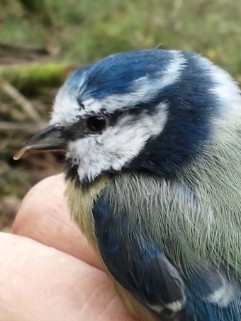Consequences and odd behaviours
Many birds adapt to their unusual beak and a surprising number remain in good condition, even able to find mates and breed. Successful adaptation appears to be more likely if the change in beak morphology (i.e. its form) occurs gradually rather than as a result of sudden injury.
Feeding
Birds with damaged beaks are often drawn to garden feeding stations or other human-provided sources of food.
Some birds can compensate for their deformed beak by feeding with their heads tilted to one side. Interestingly, some can even apparently benefit from their ailment. For example, one deformed Great Tit was quicker at extracting nuts from their shells than a normal individual. Drinking may also present a problem and a Blackbird with an abnormal beak has been observed collecting valuable drops from beneath leaves or drainpipes.
Breeding
Research in Alaska shows that some nesting female Black-capped Chickadees (similar in size and appearance to our Coal Tit) with deformed beaks act erratically, scattering eggs about the nest cavity rather than positioning them neatly in the nest cup. This might be because her beak is cumbersome when turning eggs, which is an essential part of successful incubation, or because of hormonal abnormalities altering her incubation behaviour. Perhaps unsurprisingly, deformed females tend to hatch fewer eggs and deformed males struggle to rear their young.
In many species, males feed their mates during the breeding season (e.g. during incubation). But when a male’s beak is deformed this process can become unwieldy. A smart female Great Tit learnt to circumvent this problem by tilting her head to one side so that she could accept nuptial gifts from her wonky-billed mate. Interestingly, problems for males do not stop there. Deformed male Black-capped Chickadees have been found tending to nests with a higher proportion of eggs that are not their own compared with the nests of normal-billed males - females seeming to covet a bit on the side with a more 'healthy' mate.
Birds with beak deformities can have difficulties preening, leading to an increased number of parasites in their plumage which, in turn, can make them less attractive to a prospective mate. Plumage that is in poor condition also functions less well, increasing the risk of mass loss and hypothermia.







Share this page